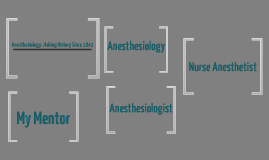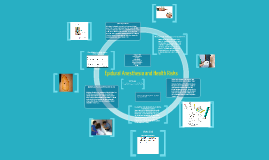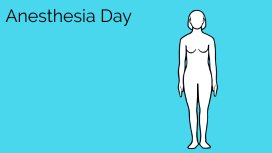Anesthesia Case Presentation
Transcript: REVIEW OF SYSTEMS Standard PACU monitoring (EKG, sO2, NIBP, temp) Pain can be treated with Hydromorphone in 0.2mg doses PONV can be treated with additional doses of Zofran 4mg q4h to maximum of 16mg Maintain normal hemodynamics (BP and HR within 20% of baseline) QUESTION 1 PATIENT AND PROCEDURE ANALYSIS: ASA 3 PLAN Induction & Airway ALL at age 6 treated with Anthracycline chemotherapy HTN (Controlled on metoprolol (baseline 142/75)) N/V and motion sickness (No treatment) Diagnosed OSA (patient snores loudly and wakes up at night) - does not tolerate his nasal CPAP BPH CVA (without deficit) preceding heart transplant Gout (Takes prenisone, recent flare up s/p prednisone dose increase) HLD Works out every other day (heavy weight lifting and cardio) Discussion with surgeon regarding positioning prone position may require ETT intubation, which will require relaxation and subsequent reversal. Research shows that ProSeal LMA can be inserted and used in the prone position, and provides a seal up to 30cm H2O, reducing induction-incision time and increasing intraoperative hemodynamic stability (Brimacombe, et al, 2007) (Wekseler, et al, 2007) ultimately decided on a lateral position with the ProSeal LMA H&P reviewed Review tests as indicated from H&P TTE, Dobutamine Stress Echo, EKG, Right Heart Catheterization, Cardiac Consult (heart transplant, HTN) BUN, SCr, Renal Consult (kidney transplant) CBC (rectal bleeding) Plan discussed with patient. Consent signed and confirmed. Renal Positioning: left lateral position with right arm free draped T&S verified at blood bank Standard ASA Monitors 16-20g x 1 IV required Fluids at 5-8mL/kg/hr Ancef 1g Disposition planning: to PACU, then home thorough report to PACU nurse, verifying understanding of patient considerations Emergence Anthracycline induced cardiomyopathy s/p Orthotopic Heart Transplant in 2000 GETA with no complications noted Echo showed moderate LVH, with normal LV function (EF 55-60%) Right Heart Cath showed RV systolic pressure of 24-38 mmHg, PAP of 24/11 mmHg and Cardiac Index of 2.4 L/min/m2 Dobutamine Stress Echo from 6/2014 showed no evidence of ischemia EKG was NSR at 90 BPM CXR showed no evidence of cardiomegaly Cardiac consult: stable cardiac function with normal LV function and no evidence of vasculopathy Maintenance Cardiac Transplanted Heart transplanted heart has no sympathetic, parasympathetic, or sensory innervation, and the loss of vagal tone results in a higher than normal resting heart rate no sympathetic response to surgical stimulation, intubation, or hypovolemia is "Preload Dependent" because the heart cannot increase its rate to increase cardiac output (severed connection to carotid baroreceptors) When hepatic and renal function are normal, there is no contraindication to the use of any anesthetic drug. (Akhtar, 2012) Case reports show refractory bradycardia leading to asystole after administration of anticholinesterase neostigmine (unresponsive to anticholinergic treatment because of denervation of the heart) Indirect acting sympathomimetics are ineffective at increasing heart rate - must use epinephrine or isoproterenol EF 55-60%, negative stress echo with excellent exercise tolerance, and the patient will continue his beta blocker perioperatively. With an understanding of transplanted cardiac physiology, there is no contraindication to the planned procedure. QUESTION 2 Other PAST MEDICAL HISTORY Cancer QUESTIONS At conclusion of surgery, LMA should be removed deep to prevent coughing/bucking and potential dehiscence at surgical site adequate Vt (at least 5mL/kg) and RR (10-20/min) should be used as guides RR can guide fentanyl during emergence Treat hypotension with phenylephrine, Hypertension with Labetalol or fentanyl If plan B must be used, treat refractory bradycardia during reversal with epinephrine Transfer patient to PACU with 3L O2 via NC, give detailed report to PACU nurse, including recommendations QUESTION 4 How is the innervation of the transplanted heart different from the native heart? Akhtar, S. (2012). Ischemic Heart Disease. In Hines, R. L. & Marschall, K.E. (Eds), Stoelting's anesthesia and co-existing disease (pp. 1-30). Philadelphia: Elsevier Saunders. Brimacombe J. R., Wenzel V., Keller C. (2007) The proseal laryngeal mask airway in prone patients: A retrospective audit of 245 patients. Anaesthesia Intensive Care, 35(2):222-5. Jaffe, R. A. (2014). Anesthesiologist's manual of surgical procedures. Philadelphia: Walters Kluwer Health. Morgan, G.E., Mikhail, M. S., Murray, M. J. (2006). Clinical anesthesiology. McGraw Hill. Weksler N., Klein M., Rozentsveig V., Weksler D., Sidelnik C., Lottan M., Gurman G.M. (2007). Laryngeal mask in prone position: Pure exhibitionism or a valid technique. Minerva Anestesiology 73(1-2):33-7. Which special considerations do we take for the kidney transplant recipient? Prednisone (recently increased to 40mg) (will take DOS) Lopressor 25mg (will take DOS) ASA 81mg (continued in

















